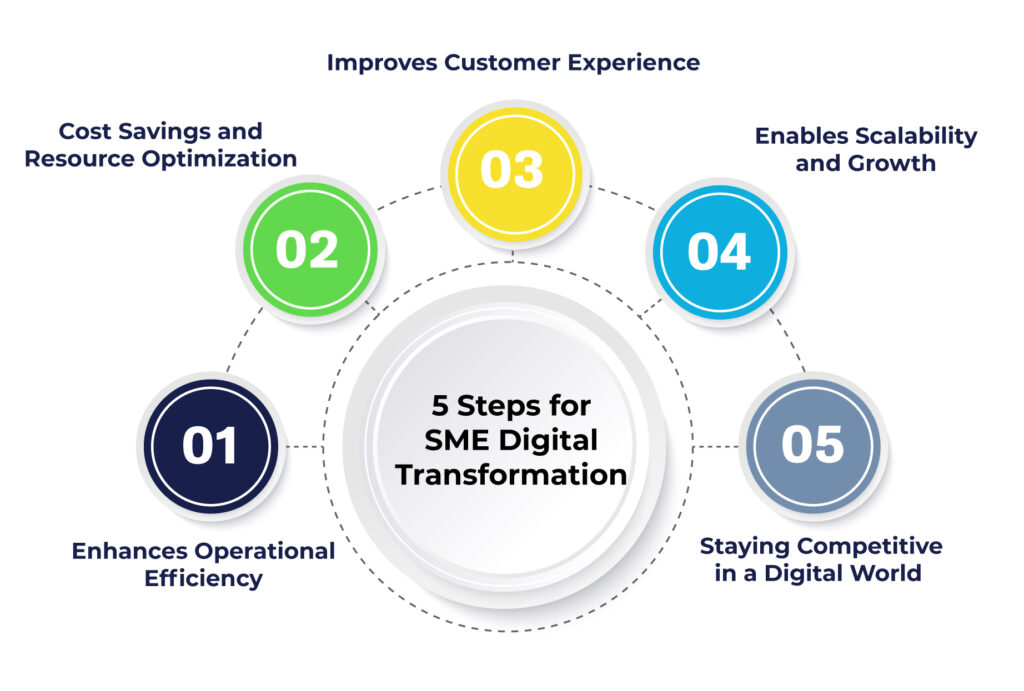
Key Technologies Driving Digital Transformation (AI, IoT, Blockchain, etc.)
Several core technologies are converging to drive digital transformation in 2025, enabling companies to move beyond simply automating processes to fundamentally reinventing business models and customer value. While AI and IoT are prominent, their impact is amplified by foundational technologies like cloud computing and new networking standards such as 5G.
Foundational technologies
-
Cloud Computing: Cloud platforms remain the backbone of modern digital transformation, offering the scalability, flexibility, and cost-efficiency needed to build and manage digital initiatives.
- Hybrid and multi-cloud: Organizations are increasingly adopting a mix of on-premises, private cloud, and multiple public cloud services to optimize workloads, avoid vendor lock-in, and meet security and compliance needs.
- Edge computing: Complementing the cloud, edge computing brings data processing closer to the source, reducing latency and enabling real-time analytics for applications in manufacturing, healthcare, and smart cities.
- 5G Networks: 5G connectivity is the catalyst that unlocks the full potential of many other technologies. Its ultra-low latency, high speed, and massive capacity for connected devices enable new use cases that were previously impossible.
- Real-time operations: 5G is critical for supporting applications like autonomous vehicles, remote-controlled robots, and high-quality telemedicine that require near-instantaneous responsiveness.
- Connected devices: It enables the massive scale of IoT deployments in smart cities, factories, and farms, where millions of devices can communicate without network congestion.
Intelligence and automation technologies
-
Artificial Intelligence (AI) and Machine Learning (ML): AI has moved from a novelty to a strategic necessity. It is the engine that drives intelligent automation, predictive analytics, and personalized customer experiences.
- Generative AI: This branch of AI is becoming a core strategic asset for automating content creation, accelerating R&D, and personalizing interactions at scale.
- Hyperautomation: This practice combines AI, ML, and robotic process automation (RPA) to automate end-to-end business workflows, leading to significant gains in productivity and accuracy.
- Predictive analytics: AI and ML analyze vast datasets to anticipate market trends, supply chain disruptions, and customer behavior, enabling proactive decision-making.
- Internet of Things (IoT): By connecting physical devices with sensors and software, IoT generates massive volumes of real-time data. This data is the fuel for AI and analytics, enabling enhanced monitoring, automation, and operational efficiency.
- Smart manufacturing: In “Industry 4.0,” IoT enables predictive maintenance on equipment, real-time quality control, and streamlined supply chain logistics.
- Customer experience: IoT-connected products and wearables gather data that helps companies understand customer usage patterns, driving better product design and personalized services.
Trust and interaction technologies
-
Blockchain: While still maturing, blockchain offers a decentralized, tamper-proof, and transparent ledger for recording transactions. It fosters trust and enhances security in ecosystems involving multiple parties.
- Supply chain visibility: It can create a transparent and verifiable record of products from origin to consumer, which helps track product authenticity and reduce fraud.
- Smart contracts: Self-executing contracts on a blockchain can automate agreements and enforce terms without intermediaries, accelerating business processes.
- Virtual and Augmented Reality (VR/AR): Beyond gaming, VR and AR are creating immersive, interactive digital experiences that are transforming customer engagement, employee training, and product design.
- Enhanced customer experience: AR apps allow customers to visualize products in their homes (e.g., IKEA furniture), while VR creates immersive virtual showrooms.
Immersive training and simulation: VR is used to train employees in high-risk environments, such as surgical procedures or aircraft maintenance, without physical danger.
